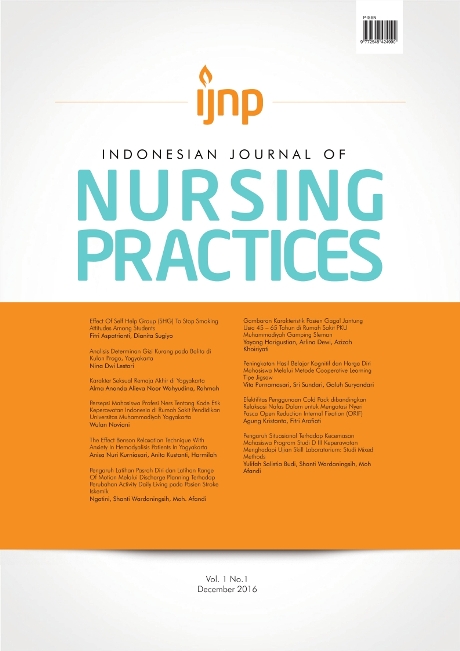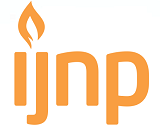MENURUNKAN TEKANAN DARAH DENGAN CARA MUDAH PADA LANSIA
DOI:
https://doi.org/10.18196/ijnp.v1i2.3438Keywords:
hipertensi, jalan kaki, lansiaAbstract
Abstrak
Latar Belakang: hipertensi adalah suatu keadaan dimana tekanan darah sistolik lebih dari atau sama dengan 140 mmHg, dan tekanan darah diastolic lebih dari atau sama dengan 90 mmHg. World Health Organization (WHO) melaporkan terdapat 12,8% kematian yang diakibatkan oleh hipertensi di seluruh dunia, dan sebanyak 40 % orang dewasa telah menderita hipertensi. Tujuan Penelitian: untuk mengetahui pengaruh jalan kaki terhadap tekanan darah pada lansia dengan hipertensi di Balai Pelayanan Sosial Tresna Werdha (BPSTW) unit Budhi Luhur, Kasongan, Bantul, Yogyakarta. Metode Penelitian: jenis penelitian ini adalah kuantitatif dengan pendekatan time series design (desain rangkaian waktu). Populasi dalam penelitian ini sebanyak 88 responden dengan sampel sebanyak 12 responden yang diambil dengan menggunakan teknik purposive sampling. Hasil Penelitian: hasil uji Wilcoxon pada sampel didapatkan hasil untuk systole dengan nilai z hitung = -2,271 dan p value sebesar 0,023 = α < 0,05. Selain itu hasil untuk diastole dengan nilai z hitung = -2,530 dan p value sebesar 0,011 = α < 0,05 yang artinya ada pengaruh antara jalan kaki terhadap tekanan darah pada lansia hipertensi. Kesimpulan: jalan kaki mempengaruhi perubahan tekanan darah (turun) pada lansia dengan hipertensi.
Abstract
Background: hypertension is a State where the systolic blood pressure is greater than or equal to 140 mmHg, diastolic blood pressure and greater than or equal to 90 mmHg. The world health organization (WHO) report there is 12.8% of deaths caused by hypertension worldwide, and as much as 40% of adults had suffered from hypertension. Purpose: to know how the walk against the blood pressure in the elderly with hypertension in the House social services Tresna Werdha (BPSTW) unit Budhi Sublime, Kasongan, Bantul, Yogyakarta. Method: the type of this research is quantitative approach to time series design (circuit design time). The population in this research as much as 88 respondents with samples as many as 12 respondents taken using purposive sampling technique. Results: Wilcoxon test results on samples obtained results for the z value of systole count =-2.271 and p value = 0.023 α < 0.05. In addition the results to calculate the z value of diastole =-2.530 and p value = 0.011 α < 0.05 meaning there influence between walk against blood pressure in elderly hypertension. Conclusion: walking affects blood pressure changes (down) on the elderly with hypertension.
References
Adib,M. 2009. Cara Mudah Memahami dan Menghindari Hipertensi, Jantung dan. Stroke. Edisi ke-2.Yogyakarta : Dianloka Printika.
Augustina. J. 2008. Impact of Exersice (walking) on Blood Pressure Levels in Hypertension in African American Adults with Newly Diagnosed Hypertension.
American College of Sports Medicine. 2004. Jurnal. Diakses pada tanggal 15 Mei2016 dari https://www.acsm.org/docs/other-documents/50-years-of-progress-and-service.pdf?sfvrsn=0
Anggraini, D.A, dkk. (2009). Faktor-Faktor yang Berhubungan dengan KejadianHipertensi pada Pasien yang Berobat di Poliklinik Dewasa Puskesmas Bangkinang Periode Januari Sampai Juni 2008. Skripsi. Di akses padatanggal 15 mei 2016 dari http://yayanakhyar.files.wordpress.com/2009/02/files-of-drsmed-faktor-yang-berhubungan-dengan-kejadian-hipertensi.pdf.
Bare BG., Smeltzer SC. 2001. Buku Ajar Keperawatan Medikal Bedah. Jakarta: EGC.
Boedhi, Darmojo, R. 2011. Buku Ajar Geriatic (IlmuKesehatanLanjutUsia) edisi ke – 4.Jakarta :BalaiPenerbit FKUI
BPS, 1992. Jumlah Hipertensi di Indonesia. Jakerta: BPS Pusat.
Dalimartha, S. et al. 2008. Care Your Self Hipertensi. Jakarta: Penebar Plus +
Depkes RI. 2001. Pedoman Pengukuran dan Pemeriksaan. Jurnal. Depkes RI, Jakarta.
_________. 2006. Pedoman Pengukuran dan Pemeriksaan. Jurnal. Depkes RI, Jakarta.
Dinas Kesehatan Provinsi DIY. 2013. Profil Kesehatan DIY 2013. Yogyakarta : Dinas Kesehatan DIY 2013.
Dinkes DIY, 2013. Laporan Survailans Terpadu Penyakit (STP) Puskesmas di DIY pada tahun 2012,
Elsanti, Salma. 2009. Panduan Hidup Sehat Bebas Kolesterol, Stroke, Hipertensi & Serangan Jantung. Yogyakarta : Araska.
Fernando Dimeo,
Handayani dan Riyadi, 2011. Pedoman Penelitian Karya Tulis Ilmiah Bidang Kesehatan. Yogyakarta : Samodra Ilmu Perss
Hans. Tandra. 2003. Merokok dan. Kesehatan. http://www.kompas.co.id/kesehatan/news/0306/30/105012.htm, 24 juni 2007
Hikmaharidha. 2011. Pengaruh Senam Tai Chi Terhadap Tekanan Darah Wanita Berusia 50 Tahun Keatas. Skripsi.
J E Martin, P M Dubbert. Controled Trial Aerobic Exersice of Hypertention, Dallas 1990.
Karyadi, E. 2002, Hidup Bersama Penyakit Hipertensi, Asam Urat dan Jantung. Koroner. Jakarta : Intisari Mediatama.
Kementrian Kesehatan RI. (2013). Riset Kesehatan Dasar 2013. Jakarta : Kementrian Kesehatan RI 2013.
Krummel, D.A. 2004. Medical Nutrition Therapy in Cardiovascular Disease. In:Mahan, L.K. & Escott-Stump, S., ed. Krause's Food, Nutrition, & Diet.
Kumar, 2005. Kumar V, Abbas AK, Fausto N. Hypertensive Vascular Disease. In: Robn and Cotran Pathologic Basis of Disease 7th edition. Philadelpia : Elsevier https://id.wikipedia.org/wiki
Kusuma, D. 2006. Olahraga Untuk Orang Sehat dan Penderita Penyakit Jantung. (Internet) http://www.afand.abatasa.com.(aAccessed 10 Juni 2015).
Machfoedz, Ircham. 2014. Metodologi Penelitian Kuantitatif. Yogyakarta: Fitramaya.
Marliani L, S Tantan. 2007. 100 Questions & Answer Hipertensi. Jakarta: Elex Media Komputindo.
Marya, et al. 2008. Mengenal Usia Lanjut dan Perawatannya. Jakarta: Salemba.
Murwani, et al. 2010. Gerontik konsep dasar dan asuhan keperawatan home care dan komunitas. Yogyakarta : Penerbit Fitramaya.
National Institutes of Health. 2004. Prevention, Detection, Evaluation, andTreatment of High Blood Pressure (JNC 7).Jurnal. U.S. Department Of Health And Human Services
Notoatmodjo, Soekidjo. 2012. Mtodologi Penelitian Kesehatan, Edisi Revisi. Jakarta : Rineka Cipta.
Larisa, et al. 2013. Hubungan Kebiasaan Berolahraga Jalan Kaki Dengan Kontrol Tekanan Darah Pada Pasien Hipertensi.
Rohaendi. 2008. Treatment Of High Blood Pressure. Jakarta :Gramedia Pustaka Utama.
Rusdi &Nurlaela Isnawati. (2009). Awas! Anda bisa mati cepat akibat hipertensi &diabetes. Yogyakarta : Power Books (IHDINA).
Saraswati, S. 2009. Diet Sehat Untuk Penyakit Asam Urat, Diabetes, Hipertensi, dan Stroke. Jogjakarta : A+Plus.
Syatria, A. 2006. Pengaruh Olahraga terprogram terhadap tekanan darah pada mahasiswa fakultas kedokteran universitas diponegoro. FK UNDIP. Semarang.
Sidang. 2006. “Pengaruh Olahraga Terhadap Penurunan Tekanan Darah pada Penderita Hipertensi di Klub Jantung Sehat Bhumi Phala Kabupaten Temanggung”. Skripsi.
Sugiyono, 2010. Metode Penelitian Kualitatif Kuantitatif & RND. Bandung:Alfabeta.
Susalit dkk, 2001. Hipertensi Primer Dalam Buku Ajar Ilmu Penyakit Dalam, Edisi III, Jilid II. Jakarta: Balai Penerbit FKUI.
Sustrani, Lanny, dkk. 2006. Hipertensi. Jakarta : PT Gramedia Pustaka Utama.
Sutanto. 2009. Awas 7 Penyakit Degeneratif, Paradigma Indonesia,Yogyakartahttps://id.wikipedia.org/wiki.
Thristyaningsih. 2009. Pengaruh Senam Bugar Lansia Terhadap Daya Tahan Jantung Paru, Status Gizi dan Tekanan Darah Lansia Hipertensi di Posyandu Kecamatan Pahandut. Kota Palangkaraya. Tesis. FK UGM. Yogyakarta.
Waren, et al. 2009. Faktor-Faktor Yang Berhubungan Dengan Kejadian Hipertensi Pada Pasien Yang Berobat Di Poliklinik Dewasa Puskesmas Bangkina Periode Januari Sampai Juni 2008. FK. UNRI. Riau
World Health Organisation (WHO). 2011. Global Adult Tobacco Survey:Indonesia Report 2011. Jurnal. Jakarta.
Downloads
Published
Issue
Section
License
License
Articles published in the IJNP (Indonesian Journal of Nursing Practices) are licensed under a Attribution 4.0 International (CC BY 4.0) license. You are free to:
- Share — copy and redistribute the material in any medium or format.
- Adapt — remix, transform, and build upon the material for any purpose, even commercially.
This license is acceptable for Free Cultural Works. The licensor cannot revoke these freedoms as long as you follow the license terms. Under the following terms:
Attribution — You must give appropriate credit, provide a link to the license, and indicate if changes were made. You may do so in any reasonable manner, but not in any way that suggests the licensor endorses you or your use.
- No additional restrictions — You may not apply legal terms or technological measures that legally restrict others from doing anything the license permits.
Copyright
Authors who publish with IJNP (Indonesian Journal of Nursing Practices) agree to the following terms:
- Authors retain copyright and grant IJNP (Indonesian Journal of Nursing Practices) the right of first publication with the work simultaneously licensed under an Attribution 4.0 International (CC BY 4.0) that allows others to remix, adapt and build upon the work with an acknowledgment of the work's authorship and of the initial publication in IJNP (Indonesian Journal of Nursing Practices).
- Authors are permitted to copy and redistribute the journal's published version of the work (e.g., post it to an institutional repository or publish it in a book), with an acknowledgment of its initial publication in IJNP (Indonesian Journal of Nursing Practices).















